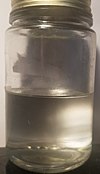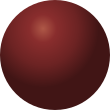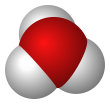Hydrobromic acid
| |||
| |||

| |||
| Names | |||
|---|---|---|---|
| Other names
Hydronium bromide
| |||
| Identifiers | |||
| |||
3D model (JSmol)
|
|||
| ChEBI | |||
| ChEMBL | |||
| ChemSpider | |||
| ECHA InfoCard | 100.240.772 | ||
| EC Number |
| ||
| 620 | |||
| KEGG | |||
PubChem CID
|
|||
| RTECS number |
| ||
| UNII | |||
| UN number | 1048 1788 | ||
| Properties | |||
| HBr(aq) | |||
| Molar mass | 80.91 g·mol−1 | ||
| Appearance | colorless/faint yellow liquid | ||
| Odor | acrid | ||
| Density | 1.49 g/cm3 (48% w/w aq.) | ||
| Melting point | −11 °C (12 °F; 262 K) (47–49% w/w aq.) | ||
| Boiling point | 122 °C (252 °F; 395 K) at 700 mmHg (47–49% w/w aq.) | ||
| 221 g/100 mL (0 °C) 204 g/100 mL (15 °C) 130 g/100 mL (100 °C) | |||
| Acidity (pKa) | −9[1] | ||
| Viscosity | 0.84 cP (−75 °C) | ||
| Thermochemistry | |||
Heat capacity (C)
|
29.1 J/(K·mol) | ||
Std molar
entropy (S |
198.7 J/(K·mol) | ||
Std enthalpy of
formation (ΔfH⦵298) |
−36.3 kJ/mol | ||
| Hazards | |||
| Safety data sheet | ICSC 0282 | ||
| GHS pictograms |  
| ||
| GHS Signal word | Danger | ||
GHS hazard statements
|
H314, H335 | ||
| P260, P261, P264, P271, P280, P301+330+331, P303+361+353, P304+340, P305+351+338, P310, P312, P321, P363, P403+233, P405, P501 | |||
| NFPA 704 (fire diamond) | 
3
0
0 ACID | ||
| Flash point | Non-flammable | ||
| Related compounds | |||
Other anions
|
Hydrofluoric acid Hydrochloric acid Hydroiodic acid | ||
Related compounds
|
Hydrogen bromide | ||
Except where otherwise noted, data are given for materials in their standard state (at 25 °C [77 °F], 100 kPa). | |||
| Infobox references | |||
Hydrobromic acid is a strong acid formed by dissolving the diatomic molecule hydrogen bromide (HBr) in water. "Constant boiling" hydrobromic acid is an aqueous solution that distills at 124.3 °C and contains 47.6% HBr by mass, which is 8.77 mol/L. Hydrobromic acid has a pKa of −9, making it a stronger acid than hydrochloric acid, but not as strong as hydroiodic acid. Hydrobromic acid is one of the strongest mineral acids known.
Uses[]
Hydrobromic acid is mainly used for the production of inorganic bromides, especially the bromides of zinc, calcium, and sodium. It is a useful reagent for generating organobromine compounds. Certain ethers are cleaved with HBr. It also catalyzes alkylation reactions and the extraction of certain ores. Industrially significant organic compounds prepared from hydrobromic acid include allyl bromide, tetrabromobis(phenol), and bromoacetic acid. HBr almost uniquely participates in anti-Markovnikov hydrohalogenation of alkenes. The resulting 1-bromoalkanes are versatile alkylating agents, giving rise to fatty amines and quaternary ammonium salts.[2]
Synthesis[]
Hydrobromic acid can be prepared in the laboratory via the reaction of Br2, SO2, and water.[3]
- Br2 + SO2 + 2 H2O → H2SO4 + 2 HBr
More typically laboratory preparations involve the production of anhydrous HBr, which is then dissolved in water.
Hydrobromic acid has commonly been prepared industrially by reacting bromine with either sulfur or phosphorus and water. However, it can also be produced electrolytically.[3] It can also be prepared by treating bromides with non-oxidising acids like phosphoric or acetic acids.
Alternatively the acid can be prepared with dilute (5.8M) sulfuric acid and potassium bromide:[4]
- H2SO4 + KBr → KHSO4 + HBr
Using more concentrated sulfuric acid or allowing the reaction solution to exceed 75 °C further oxidizes HBr to bromine gas. The acid is further purified by filtering out the KHSO4 and by distilling off the water until the solution reaches an azeotrope (≈ 126 °C at 760 torr). The yield is approximately 85%.[4]
Hydrobromic acid is available commercially in various concentrations and purities.
References[]
- ^ Bell, R. P. The Proton in Chemistry, 2nd ed., Cornell University Press, Ithaca, NY, 1973.
- ^ Dagani, M. J.; Barda, H. J.; Benya, T. J.; Sanders, D. C. (2012). "Bromine Compounds". Ullmann's Encyclopedia of Industrial Chemistry. Weinheim: Wiley-VCH. doi:10.1002/14356007.a04_405.
- ^ Jump up to: a b Scott, A. (1900). "Preparation of Pure Hydrobromic Acid". Journal of the Chemical Society, Transactions. 77: 648–651. doi:10.1039/ct9007700648.
- ^ Jump up to: a b Brauer, Georg (1963). Handbook of Preparative Inorganic Chemistry. 1 (2nd ed.). New York: Academic Press. p. 285. ISBN 978-0121266011.
External links[]
![]() Media related to Hydrogen bromide at Wikimedia Commons
Media related to Hydrogen bromide at Wikimedia Commons
- Bromides
- Nonmetal halides
- Mineral acids



